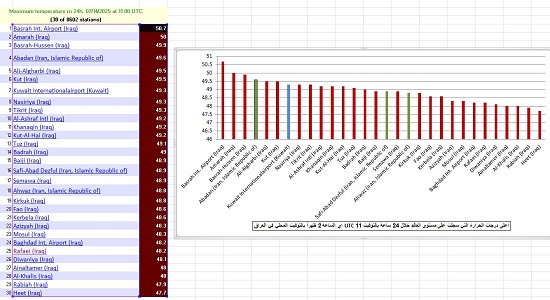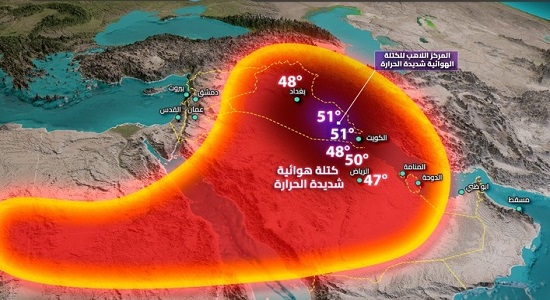|
Thermal dome ignites the summer of Mesopotamia, when Iraq's summer becomes a test of resilience
2025-09-08

Assistant Professor Dr. Ahmed Jassam Makhlaf
Department of Climate and Meteorology – Upper Euphrates Center for Sustainable Development Research – University of Anbar
At the beginning of July, Iraq entered a rare climatic state known as the "Heat Dome", which is an upper atmospheric centralization that prevents the flow of cold air down and the confinement of heated hot air masses under it. This thermally closed system leads to high temperatures day after day, turning Iraq's atmosphere into a hot atmospheric pressure furnace in the full sense of the word. On July 1, 2025, the maximum temperature ranged between (39oC) in humid western Iraq, (41oC) in Erbil, (44oC) in Baghdad and (46oC) in Basra, while on July 14, 2025, Iraq's stations recorded the highest temperatures in the world, as the data in the figure below shows a list of the highest temperatures recorded during 24 hours at 11:00UT, ( i.e. 2 pm local time in Iraq), among the 8,600 stations worldwide, of which the top 30 stations were displayed.
The result shows a remarkable level of thermal extremism in the regions of Iraq, then Iran, followed by Kuwait, as follows:
Highest temperature: 50.7°C, at Basra International Airport – a strong indicator of the intensification of the heat wave over the whole of Iraq, especially southern Iraq.
The majority of stations that recorded thermal extremism within Iraq: 25 out of 30 stations globally are within Iraq, which shows the concentration of the thermal dome in particular in the country.
Accordingly, it is noted from the following temperature distribution:
Most values range from 50.7°C to 48.2°C, i.e. all within a range considered “hazardous” to public health, especially under direct exposure.
Major cities such as Baghdad and Mosul scored close to the upper limit, which means that the heat wave is not limited to desert areas only, but also to cities due to poor planning, lack of afforestation and neglect of green areas.
The climatic situation of the Iraqi summer in July is not just a "summer heat", but the result of the interaction of several climatic factors:
The upper air elevation: (Upper Ridge) is centred over Iraq and prevents the rise of hot air or the arrival of less hot air currents.
Extension of India's low season: It pumps very dry continental air masses, especially from the Gulf and South Asian regions, to increase heat warming.
Absence of night cooling: The dome effect is not limited to the day, even during the night, temperatures remain high, which increases the heat stress of the population, and puts pressure on the electrical power system.
Iraq's geographical location between desert systems and dry plateaus.
Complexity of local terrain contributing to hot air retention.
As for the effects of this weather phenomenon on humans and the environment, the thermal dome does not limit its effects to the feeling of heat only, but extends to include:
Public health: Increased incidence of heatstroke, especially among the elderly and outdoor workers.
Electricity and water sector: High electricity consumption due to reliance on air conditioners and fans.
On the agricultural side: Extreme high temperatures, if they do not damage agricultural crops, harm them, causing a decrease in their productivity, and harming their quality.
On the water side: the lack of water in rivers due to high evaporation, which threatens local food security.
#university_of_anbar
#Upper_Euphrates_Center_for_Sustainable_Development_Research


|